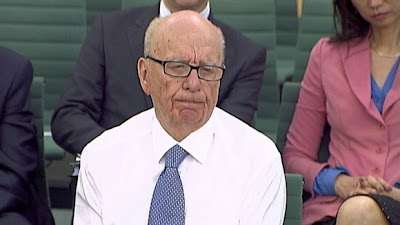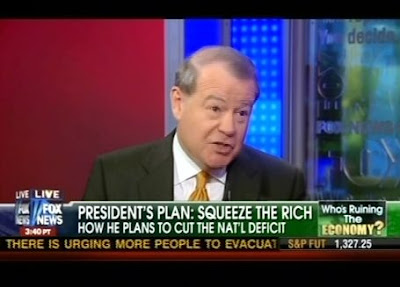
John Buell (jbuell@acadia.net) is a columnist for The Progressive Populist and a faculty adjunct at Cochise College. His most recent book, Politics, Religion, and Culture in an Anxious Age, will be published by Palgrave/Macmillan in August.
Will Rupert Murdoch's public humiliation end with the indictment of his son and deposing both as leaders of News Corporation? Murdoch is of course a larger than life figure, a modern day Citizen Kane, the movie character based in part on the life of the real media titan of his day, William Randolph Hearst. Hearst built a media empire through yellow journalism and relentless promotion of American empire. Murdoch has helped reshape modern media, not merely in terms of corporate consolidation or political leanings but also journalistic style and redefinition of the nature and limits of political argument. But though he has helped to define the role of media tycoon in the late twentieth and twenty first century, the evolution of capitalism and its political economy has itself reinforced and in turn been buttressed by his performance. Great actors inspire but also depend on engaged and receptive audiences.

Rupert Murdoch did not begin the process of media consolidation. A generation ago, media scholar and critic Ben Bagdikian highlighted the tendency of corporate media empires to achieve a high degree of both vertical and horizontal integration. (See his book, New Media Monopoly.) Diminishing numbers of corporate media controlled most of the market. In Britain, Murdoch has achieved an unprecedented degree of media consolidation.

That success of course owes something to Murdoch's ability to appeal to--and sow--the politics of backlash and jingoism. Murdoch had a cultural climate that proved receptive. The mainstream media of the sixties and seventies did indeed show some sympathy to growing concerns over racial justice and social issues. Radical critiques of corporate capitalism or sympathetic analyses of the plight of working class whites in an era of outsourcing, however, were hardly to be found. Murdoch had a perfect sweet spot to spread his right wing populism.

Murdoch's success has had other drivers as well. Like the large investment banks and defense contractors, he has depended on a symbiotic relationship with major political leaders. John Nichols points out: "Rupert Murdoch has manipulated not just the news but the news landscape of the United States for decades. He has done so by pressuring the Federal Communications Commission and Congress to alter the laws of the land and regulatory standards in order to give his media conglomerate an unfair advantage in 'competition' with more locally focused, more engaged and more responsible media. It's an old story: while Murdoch's Fox News hosts prattle on and on about their enthusiasm for the free market, they work for a firm that seeks to game the system so Murdoch's 'properties' are best positioned to monopolize the discourse." Murdoch is a prime example of the evolution of US capitalism toward a political economy that imposes market discipline on the poor even as it rewards and buttresses the power of the corporate winners and the wealthy.

Source: the Media Reform Information Center.
Nichols also asks if we should care about Murdoch's journalistic triumph. He suggests that the Murdoch scandal "raises huge questions about how news stories are and will be obtained in an era of new media and about the extent to which supposedly personal communications are private." These are certainly valid points, but a ruthless pursuit and exploitation of information about the private lives of its subjects has early precursors within the national security state itself. Think of J Edgar Hoover's accumulation of information about the sexual predilections of political leaders and his shameless deployment of these to bribe his nominal superiors.
More broadly, Murdoch feeds but also reflects a politics of demonization not unique to the United States but exceptionally potent here. Thus to a greater extent than in most modern democracies, such questions as whether one inhaled marijuana or had a mistress pass for informed and important political debate.

Murdoch and his minions may face criminal charges. His singular ability to sense cultural vulnerabilities and ruthlessly to unearth and exploit personal failings or eccentricities has altered the media and political world. But neither our media nor our progressive politicians should indulge in anti-Murdoch vendettas and frame him as symbol and root of our troubles. True, he is an ideal villain and we love villains. But absent much stronger barriers to media consolidation and more opportunities for a diverse, citizen-journalist- and- consumer- directed media, where something other than advertiser dollars are the prime driver and motivation. Murdoch's demise will do us little good. Perhaps the role of the few remaining independent voices like the Guardian in exposing Murdoch and the truly ghastly practices to which News Corporation has stooped will help foster broad media and economic reform. (See http://www.democracynow.org/2011/7/21/murdoch_empire_pummelled_by_phone_hacking).





























